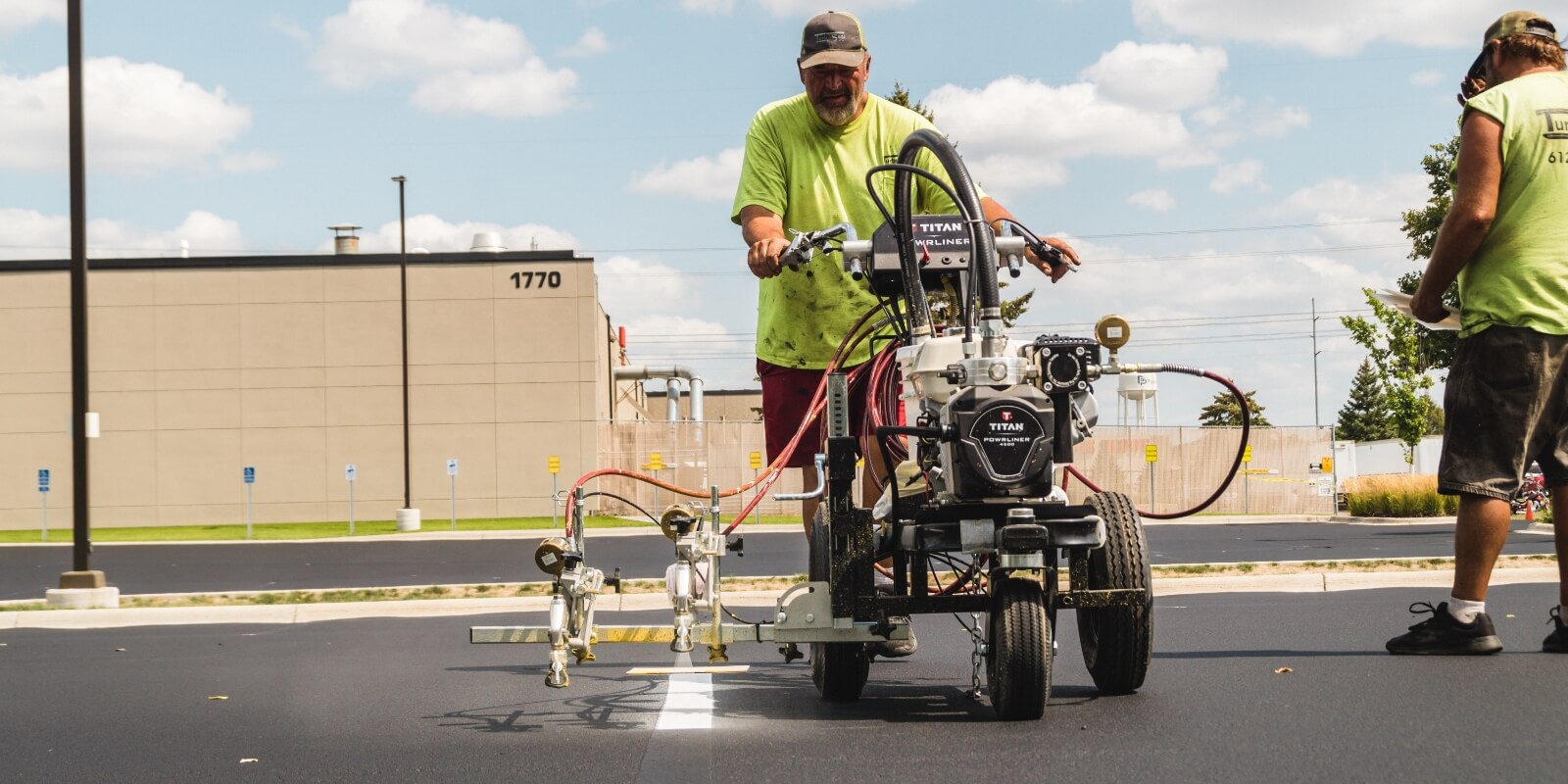
Whether working in field striping or pavement marking, high-quality line striping is all about laying down crisp, consistent, and straight lines every time you pull the trigger. And the quickest and easiest way to do so is with a professional-grade line striping machine.
Most line stripers are equipped with wheels for easy movement and steering, and many also have locking front wheels that make perfectly straight lines even more achievable – all in a fraction of the time of manual methods.
But while it may be easy for even novices to get started using a line striper, there are still several things every user should know before taking to the field or pavement. Here are five tips to help improve your line striping performance and results across a wide variety of applications.
1. Prepare Your Surface Before Striping
Line striping paint may be highly adhesive, but it is still important to clean the pavement before applying new paint. You don’t need to remove any old lines completely, but any debris caught between them and the fresh new coat of paint will contribute to quicker deterioration.
A good sweep is usually all it takes to remove any dirt, vegetation, or other debris there may be on the surface. A wire brush can also help in areas where standing water can cause dirt to cake on over time.
Pressure washing may be tempting, and while it cleans quickly and effectively, it can take a couple days to dry after the fact. Depending on your specific project, that may be time you’re unable to spare.
You should also make sure the surface is free of mold prior to line striping. An easy yet effective way to remove mold from a surface is with a hand sprayer filled with 50% sodium hypochlorite and 50% water. This method works well on both live mold and dormant mold spores.
The preparation for field striping is not quite as intensive, but you should still make sure the surface is mowed and in relatively good condition before laying down any new lines. Doing so helps ensure your lines are as straight and even as they can be, as unruly or long grass can cause unusual patterns to occur.
2. Choose the Right Paint
Before line striping, you also want to make sure you’ve chosen the right paint for the job. There are generally two types of line striping paint:
- Oil-based alkyd paint, which is widely used for restriping projects and new layouts
- And latex paint, which is commonly used for resurfacing lots (although it can also work for restriping and new layouts)
3. Monitor the Engine and Pump Pressure
Line striping is a fairly easygoing process when done correctly, but there are still some things to keep an eye on as it pertains to your line striping machine.
Running the throttle and pressure too high can place excessive strain on the machine and can also waste fuel. You should allow the engine to run at a slow, steady pace in order to reduce the amount of pressure put on the machinery. This also helps save fuel and can produce more even lines throughout the project.
Adjusting the speed of the engine to align with the flow rate of the spray tip is also an important step in achieving optimal results.
4. Have Several Different Tips on Hand
While adjusting your machine’s pressure is a good way to vary the amount of paint applied, it is not the most efficient. Swapping out tips is the quickest and easiest way to change the width of the spray pattern and the flow rate.
This also allows you to maintain an optimal operating pressure while regulating your rate of application. For this reason, it is typically a good idea to keep multiple tips on hand during the line striping process.
5. Properly Flush and Store Your Line Striping Machine
Improperly flushing or storing your machine when not in use can cause serious issues down the road, so you should always make sure you’re following the appropriate steps after a job. Leaving water or air in the machine while storing it can damage the packing and metal components. Before storing, be sure to flush the machine and to never store it under pressure.
To reduce the pressure, load the machine with mineral spirits, circulate them around the system under low pressure, shut off the pump, and then open the prime valve. Once you’ve relieved the pressure, close the prime valve. You are now ready to safely store your machine.
Lay Down Cleaner, Easier Lines with Titan Tool
The PowrLiner Series of line striping equipment from Titan Tool helps you leave your mark in all the right places on pavement and field striping jobs. Built with technology that delivers a best-in-class stripe with sharp and consistent line quality, the PowrLiner 4500 is designed to withstand the rigors of steady, everyday use on pavement, fields, and turf.
It’s the perfect intermediate line striper for contractors who need a maneuverable, medium-duty line striper for projects where the big machines just aren’t profitable to operate.
Specs and features include:
- Max delivery: 1.25 GPM
- Max operating pressure: 3300 psi
- Engine: Honda GX160 with low oil alert
- Ability to stripe with either 1 or 2 guns
- PermaStroke Technology™ for a lifetime of durability with no piston or packings to replace and only two field serviceable wear parts
- Sealed hydraulic system with no electronics or clutches to burn out
Learn more about the PowrLiner 4500 here and contact us today to start experiencing better results on pavement, fields, and turf of any kind.

